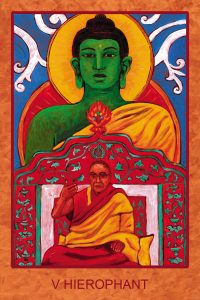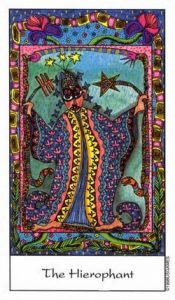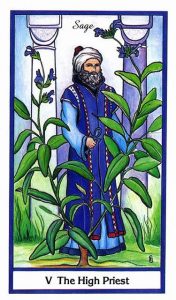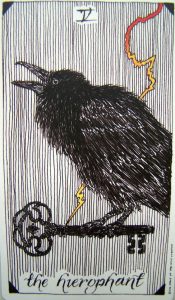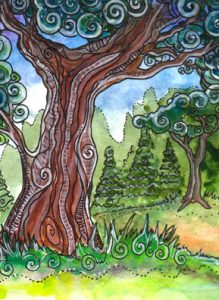5 - The Hierophant
Meaning: Traditional values, marriage, the tried and the true, conventional wisdom.
A gallery of some of the many artistic expressions of The Hierophant tarot card taken from beautiful and contrasting tarot decks.
The Hierophant Tarot Card: Embracing Tradition in Spiritual Exploration
The Hierophant tarot card, often depicted as a figure in religious garb seated between two pillars, is a potent symbol rich in esoteric significance. It holds a prominent place in the Major Arcana, the foundational cards of the tarot deck, representing profound spiritual teachings and guidance. In this detailed article we delve into the depths of The Hierophant tarot card, examining its symbolism, meaning, and interpretations, shedding light on its relevance in various aspects of life.
Understanding the Hierophant
Before delving into the intricacies of The Hierophant tarot card, it's crucial to grasp the essence of the archetype it embodies. The term "hierophant" originates from the Greek "hierophantes," meaning "one who reveals sacred things." In ancient Greece, the hierophant was the chief priest responsible for interpreting sacred mysteries and rituals, acting as an intermediary between the divine and the mortal realms.
Symbolism of The Hierophant
The imagery depicted in The Hierophant tarot card is laden with symbolism, each element contributing to its multifaceted meaning:
- The Hierophant Figure: Central to the card is the figure of the hierophant himself, often depicted as a religious or spiritual authority figure. He symbolizes tradition, orthodoxy, and the adherence to established societal norms and institutions.
- The Papal Staff: In his hand, the hierophant holds a papal staff, signifying his spiritual authority and leadership. It represents the connection to divine wisdom and the transmission of sacred teachings.
- The Two Pillars: Flanking the hierophant are two pillars, reminiscent of those found in ancient temples. These pillars symbolize duality, such as masculine and feminine energies, and the balance between opposing forces.
- The Triple Crown: Some depictions of The Hierophant feature a triple crown atop his head, representing the three realms of existence: the physical, the mental, and the spiritual.
- The Worshippers: Often depicted kneeling before the hierophant are two figures, representing disciples or followers seeking guidance and enlightenment. They symbolize the importance of mentorship, tradition, and spiritual community.
Meaning and Interpretation
In tarot readings, The Hierophant tarot card carries various meanings depending on the context of the question and its placement within the spread. Here are some common interpretations:
- Tradition and Conformity: The Hierophant often signifies adherence to tradition, conventional values, and established institutions. It may suggest a need to conform to societal expectations or seek guidance from authoritative figures.
- Spiritual Guidance: As the embodiment of spiritual wisdom and leadership, The Hierophant indicates a time for seeking guidance from mentors, teachers, or spiritual advisors. It encourages connecting with higher realms and delving into spiritual practices.
- Education and Learning: The card can also represent formal education, religious studies, or apprenticeship. It suggests a period of learning and acquiring knowledge from experienced sources.
- Moral and Ethical Principles: The Hierophant urges adherence to moral and ethical principles, emphasizing integrity, honesty, and righteousness. It prompts introspection and alignment with one's values.
- Conventional Relationships: In relationship readings, The Hierophant may signify traditional or conventional partnerships, such as marriage or committed unions. It emphasizes loyalty, commitment, and shared beliefs.
Reversed Interpretation
When The Hierophant appears reversed in a tarot reading, its meanings may shift or become distorted:
- Rebellion Against Tradition: The reversal could indicate a rebellion against societal norms, traditions, or authority figures. It suggests a desire to break free from constraints and forge one's path.
- Spiritual Disillusionment: Reversed, The Hierophant may signal spiritual disillusionment, confusion, or skepticism towards established beliefs and practices. It suggests a need for inner reflection and seeking alternative perspectives.
- Unorthodox Paths: It may also suggest exploring unconventional or non-traditional spiritual paths and ideologies. The reversal encourages embracing diversity and open-mindedness.
- Dogmatism and Rigidity: In some cases, the reversal of The Hierophant warns against dogmatism, rigidity, or blind adherence to authority. It prompts flexibility and critical thinking.
- Breaking Tradition: Reversed, The Hierophant could indicate a need to challenge the status quo, break free from oppressive structures, and embrace individuality and autonomy.
The Hierophant: Yes or No?
In yes or no tarot readings, The Hierophant's appearance suggests a positive outcome when the question pertains to seeking guidance, following established protocols, or committing to traditional paths. However, if the inquiry involves rebellion, defiance against authority, or unconventional choices, the answer may lean towards no or require further contemplation.
Love and Relationships
In matters of love and relationships, The Hierophant tarot card symbolizes commitment, loyalty, and shared values. It suggests the importance of building a solid foundation based on mutual respect, trust, and traditional values. For singles, it may indicate meeting a partner through religious or educational settings or seeking guidance from spiritual mentors. However, in reversed positions, it could signify conflicts arising from differences in belief systems or a need to reassess relationship dynamics.
The Hierophant as Feelings
When The Hierophant represents someone's feelings in a tarot reading, it suggests respect, admiration, and a sense of reverence towards traditional values and beliefs. The person may view the relationship through a lens of commitment, stability, and spiritual connection. Alternatively, if reversed, it may indicate feelings of rebellion, skepticism, or a desire to break free from conventional norms within the relationship.
Common Misspelling
It's worth noting that the word "hierophant" is often misspelled as "heirophant," reflecting the complexities of language and the nuances of esoteric terminology.
In conclusion, The Hierophant tarot card serves as a powerful symbol of spiritual guidance, tradition, and authority. Its imagery and meanings offer insights into navigating life's complexities, embracing wisdom, and seeking enlightenment on both personal and collective levels. Whether upright or reversed, The Hierophant invites us to explore the depths of our beliefs, challenge societal norms, and embark on a journey of self-discovery and spiritual growth.

